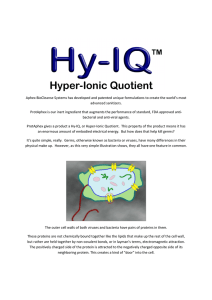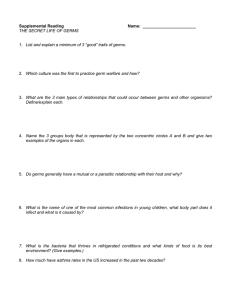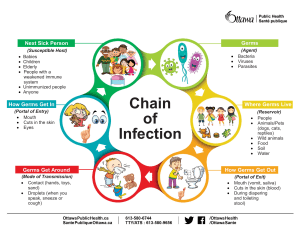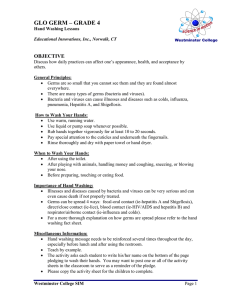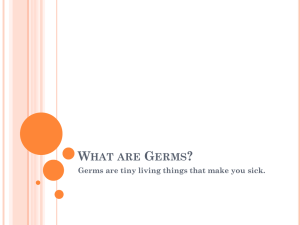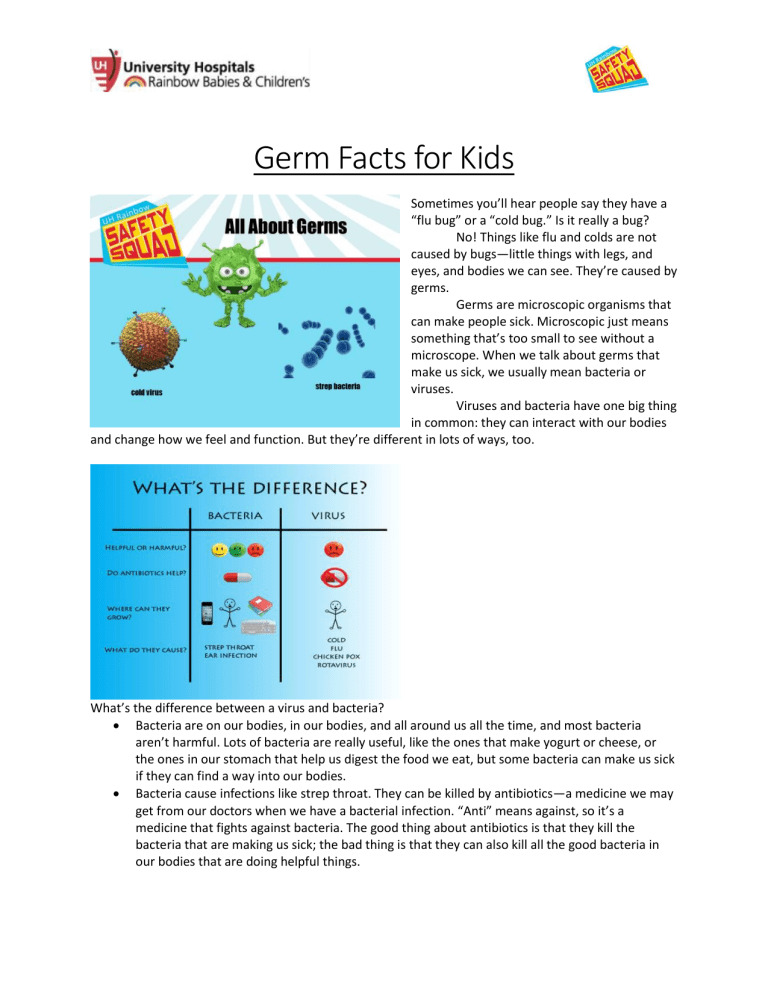
Germ Facts for Kids Sometimes you’ll hear people say they have a “flu bug” or a “cold bug.” Is it really a bug? No! Things like flu and colds are not caused by bugs—little things with legs, and eyes, and bodies we can see. They’re caused by germs. Germs are microscopic organisms that can make people sick. Microscopic just means something that’s too small to see without a microscope. When we talk about germs that make us sick, we usually mean bacteria or viruses. Viruses and bacteria have one big thing in common: they can interact with our bodies and change how we feel and function. But they’re different in lots of ways, too. What’s the difference between a virus and bacteria? • Bacteria are on our bodies, in our bodies, and all around us all the time, and most bacteria aren’t harmful. Lots of bacteria are really useful, like the ones that make yogurt or cheese, or the ones in our stomach that help us digest the food we eat, but some bacteria can make us sick if they can find a way into our bodies. • Bacteria cause infections like strep throat. They can be killed by antibiotics—a medicine we may get from our doctors when we have a bacterial infection. “Anti” means against, so it’s a medicine that fights against bacteria. The good thing about antibiotics is that they kill the bacteria that are making us sick; the bad thing is that they can also kill all the good bacteria in our bodies that are doing helpful things. • • • • Viruses are almost always bad. Most infections—like colds, flu, or chickenpox—are caused by viruses. Antibiotics only work on bacteria and don’t have any effect on viruses at all. Medicines we take when we have a cold or the flu can help some of our symptoms feel better, like a stuffy nose or cough, but they don’t actually fight the virus that’s making us sick. Another big difference between bacteria and viruses is in how they reproduce—how they make more copies of themselves. Bacteria can live almost anywhere and they can reproduce on their own, making new bacteria, so they can live for a long time outside of our bodies. Viruses can’t reproduce by themselves; they need a living host. So they can only live for a little while outside of our bodies. So how do germs get into our bodies? Germs get in through our mucous membranes. Mucous membranes are just the “moist” parts of our bodies—our eyes, nose, mouth, lungs, for example. Mucous membranes are like the doorways that germs can use to get from our environments into our bodies. Germs can travel through our mucous membranes to get into our bodies and make us sick, then all that mucous (our snot and saliva) makes it easy for us to spread our germs to other people too. We think of sneezes and coughs, but we also share mucous when we share a drink, get a kiss, use someone else’s spoon or fork, or share a snack. Knowing how sick people spread their germs is the key to knowing how we can keep from getting sick. The spread of a virus or bacteria is called transmission. There are lots of ways different germs can be transmitted between people, the two main ways are: Airborne and Contact. • In airborne transmission, droplets of germs travel through the air, where they land on you or can be breathed in by you. • In contact transmission, you get the virus or bacteria by touching an infected person, or touching something an infected person has touched. Coughing and sneezing is your body’s way of trying to get rid of harmful substances. Your body doesn’t want the germs and it tries to get rid of them. o When someone coughs or sneezes, it gets lots of little droplets in the air that you can breathe in. o The drops also land on things around the sneezer, like tables or books. Viruses can live anywhere from 20 minutes to 2 hours on surfaces like doorknobs and desks. Bacteria can live even longer! If you touch those things, the germs can get on your hands and then they can get into your body if you touch your eyes, nose, or mouth—your mucous membranes. o If you use your hands to cover your mouth or nose when you sneeze or cough, your hands get covered in germs, and you leave those germs on everything you touch until you wash your hands with soap. Anyone who touches those things after you can get the germs on their hands. Which way to sneeze do you think would do the best job of keeping those germs from spreading? Sneezing into your hands, sneezing into your elbows, or sneezing into a tissue? To prevent the spread of colds and the flu, sneeze into your elbow like a vampire! Do not sneeze into your hand- because hands spread germs!! If you cough or sneeze, or blow your nose in to a tissue, dispose of the tissue, then clean your hands with soap and water! Washing our hands is the best way to keep from getting sick. To make sure we get all the germs off, we have to use soap AND make sure we wash our hands long enough and wash them all over. Six steps for washing your hands: o palm to palm o back of our hands o in between our fingers o our thumbs o tips of our fingers/under our nails o washing our hands long enough To make sure you are washing long enough, you can sing a song—the happy birthday song or the ABC song are about the right length. Of course, we should wash our hands whenever they’re dirty, but to give us the best chance of keeping the germs out and staying healthy, we should always wash our hands these four times, even if they don’t seem dirty: • before and after eating • after using the bathroom • after touching animals • after coughing or sneezing The average person touches their face up to 60 times each hour! It’s really important to try not to touch our faces, so we don’t give those germs a chance to get in through our mucous membranes and make us sick before we have a chance to wash our hands. Quiz: 1. 2. 3. 4. 5. 6. 7. Are colds and flu caused by bugs? What are they caused by? What does microscopic mean? Name two mucous membranes that let germs into our bodies. Name two ways we can spread germs. What’s the best way to cover your sneeze or cough so you don’t spread your germs? What’s the best way to get rid of germs we might have picked up from touching a sick person or something a sick person might have touched? Answers: 1. No 2. Germs, viruses, bacteria 3. Too small to be seen without a microscope 4. Eyes, mouth 5. Coughing, sneezing, using tissues and not washing their hands 6. Sneeze or cough into your elbow 7. Wash your hands with soap and wash for the correct amount of time

